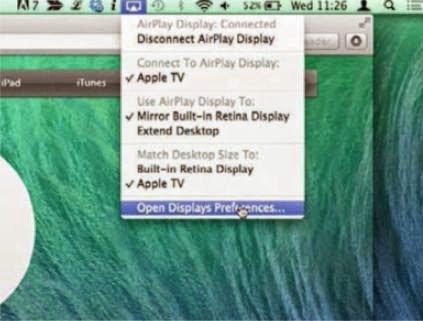AirPlay is the brilliant feature that enables you to play iTunes content on your Apple
TV, and even share your desktop. Here’s how you can make the most of it…
AirPlay is the Apple technology uses to wirelessly transfer media content between different devices in your home. The idea is that rather than having to physically wire up your laptop to your TV, or connect speakers in the living room to your iMac in the study, AirPlay provides a way to play that content over the air. Of course, one of the best places to consume your content is in the living room, on your large-screen TV using Apple TV. There are two types of AirPlay available on Apple TV. The first is the original AirPlay system, which enables you to stream your music, photos and video directly from iTunes. The second, which requires a recent Mac, enables you to use your TV as a screen for your Mac, mirroring your desktop so that you can effectively project the contents of your desktop screen onto your big-screen TV. In this tutorial we’ll look at how to set up both of these options so you can finally make full use of that tiny Apple TV box.
Different streaming options
Investigate the various ways you can stream to Apple TV
Knowledge base
Use your iPhone as a remote control
If you’re using the iTunesto Apple TV AirPlay service, you can control your iTunes library directly from your iPhone or iPod. Visit the App Store on your iOS device and download Apple’s Remote app. You’ll need to configure iTunes to accept the remote by choosing iTunes>Preferences before you can select what to play from your library.
Share your desktop
Recent Mac desktops and laptops also support desktop mirroring over AirPlay. Simply choose the AirPlay mirroring option from the system’s menubar. This will only appear when an AirPlay-capable device is available
Share from iTunes
iTunes lets you choose one or more different outlets for the content that’s currently playing. Click on the AirPlay icon within the iTunes window and choose the device(s) you’d like to stream to from the pop-up menu
Multiple devices
AirPlay is smart enough to enable you to stream to multiple devices simultaneously. While this isn’t normally the way you’d stream to Apple TV, it’s really useful if you have speakers all over your house, as you can output music to different rooms on demand
System settings
The Display Preferences menu option enables you to control the size and resolution of the mirrored display, ensuring you get the best results either for your Mac, your Apple TV or a hybrid that best works for a specific application
Step-by-step Enable AirPlay mirroring and streaming
1. Set up Apple TV
Before you can start using AirPlay on your Apple TV, you need to enable it. Open the System menu on Apple TV and choose AirPlay. Ensure AirPlay is switched on (and add a password).
2. AirPlay content
You can play any content from iTunes over a supported AirPlay device by selecting AirPlay from the iTunes window. You’ll only be able to share video content to video-capable devices.
3. Select the device
Once you’ve lined up your content, select Apple TV from the pop-up menu in iTunes. Your Apple TV will switch over to displaying your content, regardless of what it was previously displaying.
4. Mirror your desktop
If you’ve got a recent Mac you can also wirelessly share your desktop. This is great for displaying content in apps that don’t natively support AirPlay, including web TV-catchup services.
5. Screen settings
Select AirPlay Mirroring from the System menu. Once you’ve enabled mirroring, you can access a special preference setting. Choose Display Preferences from the pop-up menu.
6. Set the resolution
This preference pane lets you change how your Mac’s screen is shown both on your Mac, and on Apple TV. In most cases, simply choosing the Best for AirPlay option will suffice.
Change your display mode
Spread one desktop across two different screens
By default, the display mode settings create a mirrored display. This means that what you see on your TV screen will be a copy of what’s displayed on your Mac’s screen. This may be desirable for the majority of cases, but if you’re using AirPlay to act as a projector, you may prefer to have the TV screen act as a second monitor, adding more screen real estate, rather than simply mirroring your computer’s screen. Follow these two simple steps to see how you can make your TV a second Mac screen.
Open Display Preferences
Click on the AirPlay icon in your Mac’s menu bar, or navigate to the Apple>System Preferences> Displays option instead. Make sure that you’ve turned on AirPlay Display by selecting your Apple TV from the drop-down menu in the lower-left corner of the panel.
Change the mode
Click on the Arrangement tab to open the display arrangement options. Untick the Mirror Display checkbox. Your TV is now an extension of your desktop machine, rather than a mirror of it. You can now place the TV into a new position relative to the main display by clicking and dragging it in this window.









